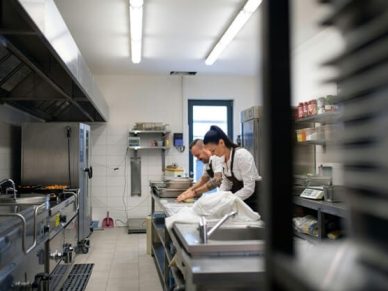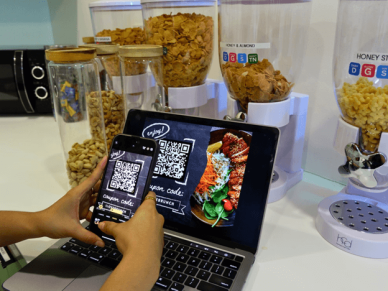Opening a restaurant is like diving headfirst into a delicious but complex recipe. It’s a thrilling blend of passion, culinary magic, and business acumen.
The aspiration to bring a unique gastronomic experience to life is met with the reality of navigating a multifaceted landscape. There’s an old saying: “It’s not all gravy!” meaning that things aren’t always as easy as they seem.
For those eager to step into the world of gastronomy, understanding the not-so-sweet parts of the restaurant business is as essential as knowing your salt from your sugar.
Ready to whisk through some insights and tips? Let’s get down to the list of essential ingredients for a successful restaurant recipe!

A Step-By-Step Guide for Aspiring Restaurant Owners
Navigating the culinary world can seem like a complex recipe, but with the right ingredients (or guidelines), success is attainable. By taking the following steps, you can steer your venture in the right direction.
Create a Business Plan
Think of a business plan as the blueprint for your restaurant. It’s not just about numbers; it’s about mapping out your vision, understanding market dynamics, analyzing competitors, and setting clear goals.
Beyond finances, your business plan is where you outline your restaurant’s ethos, culinary direction, and desired guest experience. Many seasoned restaurateurs advise revisiting and adjusting the business plan annually to keep up with evolving market trends and customer preferences.
Develop the Menu
Your menu is your brand’s ambassador. It’s the tangible reflection of your culinary vision and the promise you make to every diner that walks through your door. When planning a menu, consider factors like:
Dietary trends: Embrace the evolving dietary landscape, including preferences for vegan, gluten-free, paleo, or keto options. By doing so, you’re inviting a diverse array of patrons to indulge in your offerings.
Local preferences: Delve into the culinary preferences ingrained within your local community. Capture the spirit of your locale by presenting dishes that provide an authentic taste of the native culinary journey.
Seasonality: Embrace the ebb and flow of nature’s bounty to ensure that the core ingredients of your dishes are at the peak of freshness and flavor.
Despite the fact that new and innovative dishes can pique interest and draw crowds, maintaining consistency in taste and recipes is what will have them come back. Many renowned chefs emphasize the importance of including both seasonal dishes and traditional recipes in your menu to build a loyal customer base.
Implement Effective Supply Management
A successful dish isn’t just about the chef but also the quality of the ingredients. Once you have the menu figured out, it’s time to do the math and investigate your supply options.
Partnering with local farmers can provide an edge in freshness and authenticity. Understanding seasonality ensures your dishes capture the essence of each time of year. It’s also wise to diversify your suppliers because putting all your eggs in one basket can be risky.
Lastly, an efficient inventory system isn’t just about quantity but also quality, minimizing waste and ensuring that every ingredient used is at its prime.
Plan Your Budget and Explore Funding Options
Once you’re set up with suppliers and have the menu figured out, it’s essential to transition to another critical aspect: the finances. Navigating the culinary world without a clear financial compass can quickly lead you astray. With the intricacies of day-to-day operations, it’s easy for costs to spiral if left unchecked.
Your financial strategy can make or break your restaurant. Whether self-funded or seeking external investors, transparency is crucial. Regularly monitor your expenses, understand your cash flow, and be prepared for unforeseen challenges.
Create a Comprehensive Marketing Strategy
Just as a perfectly cooked dish needs the right presentation, your restaurant requires a well-crafted marketing strategy to make your presence known. Marketing goes beyond advertising; it’s about building a brand, fostering connections, and creating an unforgettable experience for your patrons.
Understand their preferences, demographics, and behaviors. This knowledge will guide your marketing efforts, from the content you create to the platforms you utilize. Leverage social media, email campaigns, and even partnerships with local influencers to extend your reach and entice potential customers.
Make use of your busiest hours
Be sure to use a labor management tool to help you find the right balance between how labor hours are used and how restaurant teams are backed for success each and every shift.
Choose a Good Location for Your Restaurant
A restaurant’s location can be its strongest marketing tool. Proximity to office areas, residential complexes, or tourist spots can boost footfall. Visibility and accessibility also play a vital role. A prime spot may be pricier but can pay dividends in customer traffic.
Select a Memorable Name for Your Restaurant
More than a mere label, your restaurant’s name embodies your brand’s essence. It should resonate with your offerings and the ambiance you aim to provide. A catchy, memorable name can evoke curiosity and make a lasting impression on potential customers.

Address Licensing and Obtain Essential Permits
Navigating through bureaucratic procedures can be overwhelming. Licensing prerequisites differ based on your restaurant’s nature, whether it’s takeout or involves serving alcohol.
Regular evaluations guarantee adherence, preventing substantial penalties or closures, so make sure to familiarize yourself thoroughly with the fundamental legal obligations that pertain to your business operations.
Equip Your Restaurant and Renovate With Purpose
From the kitchen to the dining area, invest in quality. Efficient equipment enhances the cooking process, and a well-renovated dining space enhances the customer’s experience. Remember, aesthetics and functionality should go hand in hand.
Assemble Your Team Through Effective Staff Scouting
Your staff is the face of your restaurant. It’s crucial to hire individuals who possess both expertise and a genuine connection to your brand. Consistent training sessions, designed to enhance skills and foster teamwork, should be an integral part of your operations.
Execute a Successful Grand Opening Event
Your launch sets the tone. A grand opening is not just about pomp; it’s about introducing your brand to the community. Engage with local influencers, organize taste-testing sessions, and perhaps offer opening discounts to attract crowds.
Embrace Modern Solutions for Long-Term Success
In the pursuit of long-term success, it’s crucial to embrace the influx of modern advancements. These include:
- Restaurant management systems: Digital platforms help manage reservations, inventory, and customer feedback effectively.
- Software for making reservations: A seamless reservation process enhances customer experience, leading to repeat visits.
- Delivery and takeaway order management: Partnering with popular delivery platforms can significantly boost sales.
- Credit card processing services: As digital payments rise, ensuring a smooth transaction process is crucial.

Unlocking Insights Through Compelling Statistics
Market analysis is a crucial aspect of every successful business, regardless of its, industry, or audience. As the competition grows fiercer and the market evolves, organizations must constantly adapt to the changes and bring new and innovative ideas to the table.
By uncovering and analyzing the statistics of the industry, you can get a better understanding of customer behaviors, predict future trends, and make decisions that will benefit your company in the long run.
Here are some interesting restaurant statistics:
- Restaurant managers are among the highest-paid professionals in the food and beverage sector, reflecting the significance of this role
- Nearly 60% of customers in the U.S. were dining out more often in 2022 compared to the previous year
- The cost of starting your own restaurant ranges from $175,500 to $750,000
- 72% of guests said the quality of food was important
- 48% of diners feel having a menu available online is an important factor when dining out.
- 86% of diners would join a loyalty program if it offered discounts and coupons.
- 97% of restaurants utilize at least one online ordering platform, with the majority using three.
Conclusion
Embarking on the restaurant journey demands more than just culinary passion; it requires sound business strategies, market awareness, and continual adaptation. Only by understanding trends, rising consumer demands, and emerging technologies can restaurateurs sustain business longevity and build powerful brand recognition.
Remember that setbacks are part of the culinary expedition. Flexibility and resilience are your allies in navigating unforeseen challenges. Whether it’s supply chain disruptions or evolving customer preferences, the ability to adapt and innovate will set you apart.















Leave a Reply